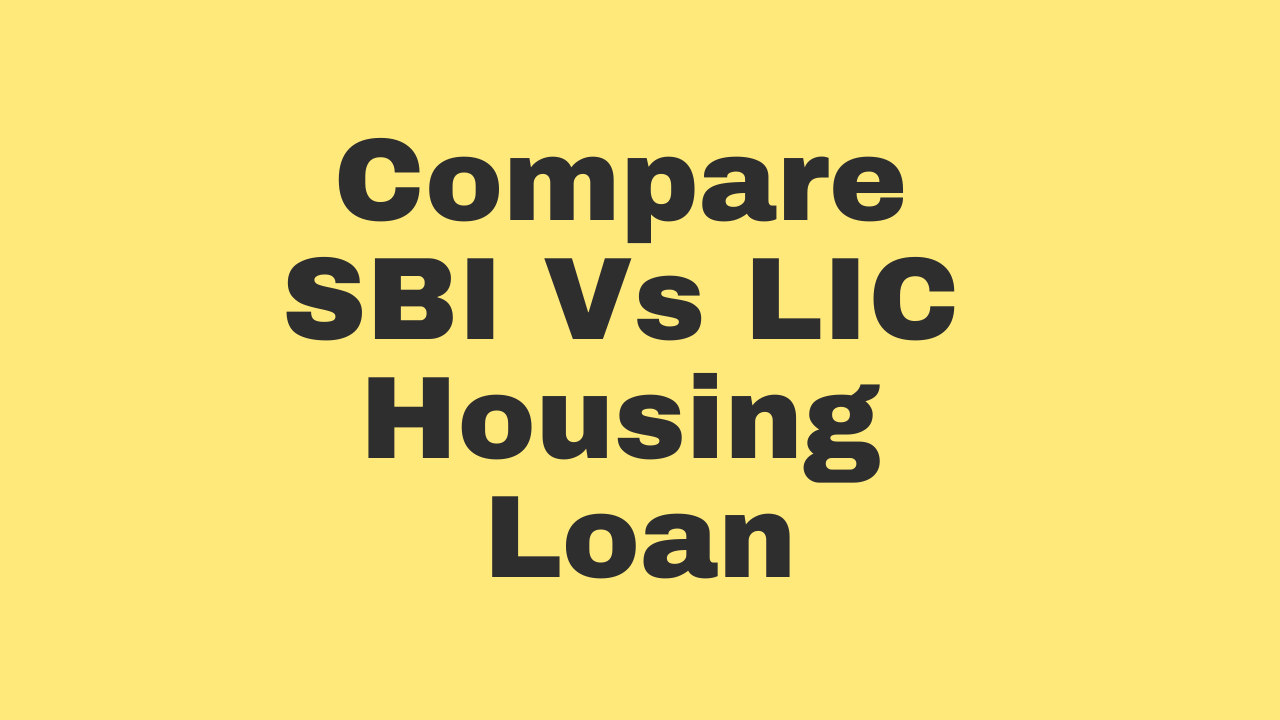Home loans play a crucial role in making home ownership dreams come true. Among the many options available, State Bank of India (SBI) and LIC Housing Finance (LIC HFL) are two of the most popular choices in India. Both lenders offer competitive interest rates, flexible tenure, and attractive features. But how do they compare?
This article provides a detailed look at SBI and LIC housing loans, including key differences, features, and comparison tables to help you make an informed decision.
SBI Housing Loan
State Bank of India (SBI) is the largest public sector bank in India, known for its extensive range of financial products, including home loans. SBI offers home loans under the SBI Home Loan brand, which provides loans for purchasing or constructing houses, buying plots, and refinancing existing home loans.
Key Features of SBI Housing Loan:
- Interest Rates: SBI offers competitive interest rates, starting as low as 8.40% p.a.
- Processing Fees: Usually ranges from 0.35% to 1% of the loan amount.
- Loan Tenure: Up to 30 years.
- Prepayment Charges: No prepayment charges for individual borrowers on floating interest rate loans.
- Special Schemes: SBI has exclusive loan schemes such as SBI Flexipay, SBI Maxgain, and SBI Realty.
LIC Housing Loan
LIC Housing Finance (LIC HFL) is a subsidiary of the Life Insurance Corporation of India (LIC). LIC HFL is a trusted name in housing finance, offering home loans for both salaried and self-employed individuals with flexible terms and conditions.
Key Features of LIC Housing Loan:
- Interest Rates: Starts at around 8.65% p.a.
- Processing Fees: Typically 0.25% to 1% of the loan amount.
- Loan Tenure: Up to 30 years.
- Prepayment Charges: No prepayment charges for floating rate loans.
- Special Schemes: Offers products like LIC Home Loan Advantage and LIC Plot Loan.
Differences Between SBI and LIC Housing Loans
While SBI and LIC Housing Finance both offer affordable housing loans, several factors set them apart. Below is a detailed comparison of the two options:
Feature | SBI Housing Loan | LIC Housing Loan |
|---|---|---|
Interest Rate | 8.40% to 9.50% p.a. | 8.65% to 9.75% p.a. |
Processing Fees | 0.35% to 1% of the loan amount | 0.25% to 1% of the loan amount |
Loan Tenure | Up to 30 years | Up to 30 years |
Prepayment Charges | Nil on floating rate loans | Nil on floating rate loans |
Loan-to-Value Ratio | Up to 90% (depends on the loan amount) | Up to 85% |
Minimum Loan Amount | ₹10,000 | ₹1 lakh |
Eligibility Criteria | Salaried, Self-employed, NRIs | Salaried, Self-employed |
Processing Speed | Generally fast, especially for pre-approved offers | Moderate, as it requires thorough documentation |
Schemes Offered | Flexipay, Maxgain, Realty, Pre-Approved Loans | LIC Home Loan Advantage, LIC Plot Loan |
Interest Rates: Detailed Comparison
Interest rates play a significant role in determining the cost of a home loan. Here’s a closer look at the interest rate offerings from both SBI and LIC HFL.
SBI Housing Loan Interest Rates
- Salaried Individuals: Starts from 8.40% p.a.
- Women Borrowers: Special rates starting from 8.35% p.a.
- SBI Flexipay Scheme: Tailored for young professionals, allows lower EMI in the initial years.
LIC Housing Loan Interest Rates
- Salaried Individuals: Interest rate begins from 8.65% p.a.
- Women Borrowers: Discounted rates available, typically 0.05% less than standard rates.
- LIC Home Loan Advantage: Flexible options for salaried borrowers with competitive rates.
Note: Interest rates are subject to change based on RBI policies, applicant’s credit score, and other criteria. Always check the latest rates with the respective bank.
Eligibility Criteria
Both SBI and LIC HFL have specific eligibility criteria for borrowers. Let’s examine these requirements in detail:
Criteria | SBI Housing Loan | LIC Housing Loan |
|---|---|---|
Age | 18 to 70 years | 21 to 70 years |
Income Source | Salaried, self-employed, NRIs | Salaried, self-employed |
Credit Score | Minimum 650 | Minimum 650 |
Employment Status | At least 2 years of stable employment | At least 2 years of stable employment |
Income Stability | Consistent income for 2+ years | Consistent income for 2+ years |
Processing Fees and Charges
Processing fees and additional charges can impact the total cost of a home loan. Here’s a comparison of SBI and LIC HFL’s fees:
Fee Type | SBI Housing Loan | LIC Housing Loan |
|---|---|---|
Processing Fees | 0.35% to 1% of loan amount | 0.25% to 1% of loan amount |
Legal and Valuation | Charged separately, typically ₹2,000 to ₹5,000 | Charged separately, usually ₹2,000 to ₹5,000 |
Prepayment Charges | No charges on floating rate loans | No charges on floating rate loans |
Penalty on EMI Delay | 1% to 2% per month on overdue EMI | 1% to 2% per month on overdue EMI |
Repayment Tenure and EMI Flexibility
Both SBI and LIC Housing Finance provide flexible repayment tenure, making it easier for borrowers to plan their finances. Here’s how their tenure options stack up:
- SBI: Offers up to 30 years, allowing borrowers to choose longer tenure for smaller EMIs.
- LIC HFL: Also provides up to 30 years, though EMI flexibility may depend on borrower profile and income level.
Tip: Opting for a shorter tenure saves interest costs but increases EMI amounts.
Prepayment and Foreclosure Options
SBI and LIC Housing Finance both allow prepayment on floating-rate loans without penalties. This can be an advantage for borrowers who want to reduce their loan burden before the completion of the tenure.
Feature | SBI Housing Loan | LIC Housing Loan |
|---|---|---|
Prepayment Charges | Nil on floating rate loans | Nil on floating rate loans |
Foreclosure Charges | Nil for individual borrowers | Nil for individual borrowers |
Customer Service and Processing Speed
SBI’s vast network of branches and digital services often makes it a faster and more accessible choice for home loan applications. However, LIC HFL also offers dedicated support, though processing might take longer due to its thorough documentation requirements.
Criteria | SBI | LIC Housing Finance |
|---|---|---|
Branch Network | Extensive, covering urban and rural areas | Limited compared to SBI |
Processing Speed | Generally faster, especially for pre-approved applicants | Moderate to slow |
Digital Services | SBI YONO app, net banking, and SMS updates | Online portal for account management |
Pros and Cons
SBI Home Loan Pros
- Lower interest rates for women.
- Wide range of products, including SBI Maxgain (overdraft facility).
- Extensive branch network and digital support.
SBI Home Loan Cons
- Higher processing fees on certain schemes.
- Longer turnaround time for documentation and processing in rural branches.
LIC Housing Loan Pros
- Competitive interest rates, especially for salaried individuals.
- Strong brand backing of LIC, ensuring trust and reliability.
- Specialized home loan products for salaried and self-employed borrowers.
LIC Housing Loan Cons
- Smaller branch network compared to SBI.
- Slower processing time due to detailed document verification.
Which is Better, SBI or LIC Housing Loan?
The choice between SBI and LIC Housing Loan ultimately depends on your individual needs and preferences. If you prefer lower interest rates, flexibility in repayment, and an extensive branch network, SBI may be more suited to your needs. On the other hand, if you’re looking for a trusted name with a focused approach to housing finance, LIC HFL could be ideal.
Key Comparison Points | Best Choice |
|---|---|
Interest Rate | SBI |
Processing Speed | SBI |
Trusted Brand | LIC HFL |
EMI Flexibility | Both |
When choosing between the two, consider factors like processing speed, tenure flexibility, and brand reliability. A lower interest rate and minimal fees can save you thousands over the life of the loan. Whether you opt for SBI or LIC Housing Loan, evaluate the latest rates, check eligibility, and plan your EMIs carefully to ensure smooth and affordable repayment.

Ranjan is a dedicated finance writer for smartfinclub.com, where he specializes in comparing top financial products in India, including loans, credit cards, savings accounts & more. With a focus on providing clear insights into features, rates, and benefits, Ranjan aims to empower readers to make informed financial decisions customized to their needs.

